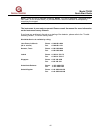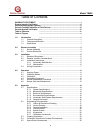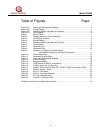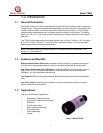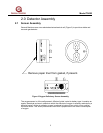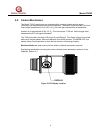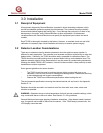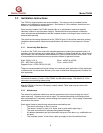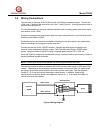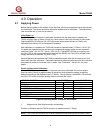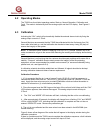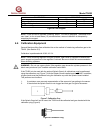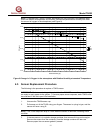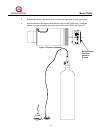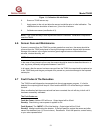
Model TS420
6
3.3 Installation Instructions
The TS420 is shipped without the sensor installed. The sensor must be installed into the
detector and calibrated for proper operation. See Section 4.5 for installation instructions and
Section 4.3 for calibration instructions.
Once correctly installed, the TS420 requires little or no maintenance other than periodic
calibration checks to ensure system integrity. General Monitors recommends a calibration
check schedule be established and that the complete system, including all alarm circuitry, be
tested at least annually.
The overall and mounting dimensions for the TS420 (Figure 12) should be used when making
installation determinations. Mechanical specifications can be found in the Appendix, Section
5.1.2.
3.3.1 Intrinsically Safe Barriers
In order for the TS420 to be used with classified equipment inside of the hazardous area, it is
necessary for the customer to purchase either a Galvanic or Zener Diode Barrier, which should
be mounted in the non-classified area between the TS420 and the facilities’ control room. A list
of recommended manufacturers and part numbers follows for galvanic barriers:
Stahl - 9303/11-22-11 Elcon - mD323 or mD325
MTL - MTL7206 or MTL5041 Turck - mk33-Li-ExO
Pepperl+Fuchs - KFD2-CR-EX1.30-300
These are recommended active type barriers for intrinsically safe applications. Each application
is different and it is the ultimate decision of the user to determine the appropriate I/S barrier for
their application.
NOTE - To maintain intrinsic safety, wire length and gauge are limited by the capacitance and
inductance of the wire, C
i
and L
i
of the TS420, and the barrier ratings. See Section 5.1.5 for
instructions on calculating these values.
Align the TS420 so that the LCD display is easily viewed. Teflon tape may be used on the
TS420’s threads.
3.3.2 Maintenance
The removal of particulate matter from sensor accessories may be done through the use of
clean water only. Solvents should not be used. The accessories should be thoroughly dried,
with compressed air if necessary, before refitting to the sensor body. Do not apply compressed
air directly to the sensor.
Some typical items to check during maintenance examinations are:
! The sensor mounting, to see it is secure.
! The sensor, to see it is clear of oil, water, dust or paint which might clog it.
! The cable connections for tightness and possible damage.
! All detector placements are up-to-date with the layout of the plant, e.g. modifications to
the plant.
! The complete system, to see it has a back up supply for the full-prescribed time.



